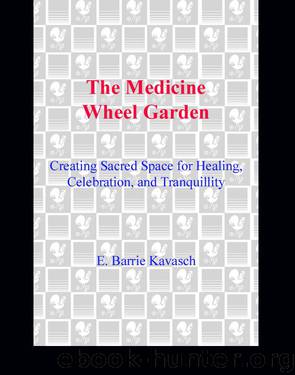The Medicine Wheel Garden by E. Barrie Kavasch

Author:E. Barrie Kavasch [Kavasch, E. Barrie]
Language: eng
Format: epub
ISBN: 978-0-307-48808-4
Publisher: Random House Publishing Group
Published: 2002-04-09T04:00:00+00:00
Companions: Echinacea grows well with other sun-loving herbs in the medicine wheel garden, especially heal-all, chili peppers, evening primrose, and yarrow.
ELDERBERRY
Sambucus Canadensis
Caprifoliaceae (honeysuckle family)
American elderberry, sweet elderberry, and elder are some common names for this native deciduous shrub. The genus name may come from the Greek word sambuke, for a musical instrument that was once made of elder wood. For centuries elderberry has been used to heal the body, mind, and spirit through its gifts of medicines and charms. The species name, canadensis, denotes Canada or the Northeast, where this plant was first identified.
Sambucus embraces about twenty species of shrubs and small trees with pithy stems that grow mainly in temperate and subtropical regions. In North America there are perhaps four species, which native populations used extensively for foods and medicines.
Elderberry grows from three to twelve feet tall in moist, rich soil and ranges from Nova Scotia to Georgia, west to Texas, and north to Manitoba. It has opposite toothed, featherlike leaves and creamy white spring flowers that form broad wheel-like, flat-topped clusters. The flowers ripen in late summer to clusters of juicy blue-black berries.
The American red elderberry, S. pubens, grows in the East, and the Pacific coast red elderberry, S. callicarpa, is found in the West along with the larger blue elderberry, S. caerulea, which can grow to twenty feet tall. All are attractive ornamentals, frequently cultivated in mass plantings for their spring blossoms and autumn fruits. All were also important American Indian medicinals. The red-berried elders are more toxic than the blue elderberry.
Traditional uses: Indians ate the elderberries ripe and dried, and the spring blossoms were used in foods and steeped into restorative teas and salves. Teas made from the inner bark served as a strong laxative, emetic, headache remedy, and diuretic; on the skin it was a valuable treatment for eczema, swellings, and skin eruptions. The Onondaga used the inner bark as an emetic to counter poisoning; it was also used to treat toothaches. The inner bark was also pounded and poulticed on cuts, burns, and sores, and on newborns’ navels, as it provided pain relief and reduced swelling. The Illinois and Miami Indians used strong root-bark decoctions to treat people with debilities and general weakness. Elderberry syrup was a treatment for coughs, colds, and flu.
Indians made hunting whistles and courting flutes from the dense, creamy white wood; the stems have a fibrous pith that can be easily hollowed out. Some tribes carved spiles for tapping sugar maple trees from elderberry, as well as from sumac wood. Indian boys fashioned blowguns from elderberry stems.
As they moved to the New World, our European ancestors brought the European elder, S. nigra, because of its vital importance in their traditional lifeways. Many believed that the elderberry was imbued with special spirits and powers. Planting an elderberry shrub touching the house was considered a deterrent to witches and ghosts, preventing them from appearing or harming the inhabitants. Our Scandinavian forebears thought that tying a cross of elderberry sticks to the head of the bed would prevent bad dreams and nightmares.
Download
This site does not store any files on its server. We only index and link to content provided by other sites. Please contact the content providers to delete copyright contents if any and email us, we'll remove relevant links or contents immediately.
Turbulence by E. J. Noyes(7720)
The Thirst by Nesbo Jo(6452)
Gerald's Game by Stephen King(4386)
Be in a Treehouse by Pete Nelson(3654)
Marijuana Grower's Handbook by Ed Rosenthal(3520)
The Sprouting Book by Ann Wigmore(3423)
The Red Files by Lee Winter(3286)
The Remains of the Day by Kazuo Ishiguro(3148)
Sharp Objects: A Novel by Gillian Flynn(2852)
Christian (The Protectors Book 1) by L. Ann Marie(2607)
Organic Mushroom Farming and Mycoremediation by Tradd Cotter(2572)
The Culinary Herbal by Susan Belsinger(2342)
Stone Building by Kevin Gardner(2297)
Lilac Girls by Martha Hall Kelly(2205)
The Starter Garden Handbook by Alice Mary Alvrez(2203)
The Unlikely Pilgrimage of Harold Fry by Rachel Joyce(2140)
The Lean Farm Guide to Growing Vegetables: More In-Depth Lean Techniques for Efficient Organic Production by Ben Hartman(2014)
Urban Farming by Thomas Fox(1987)
Backyard Woodland by Josh VanBrakle(1837)
